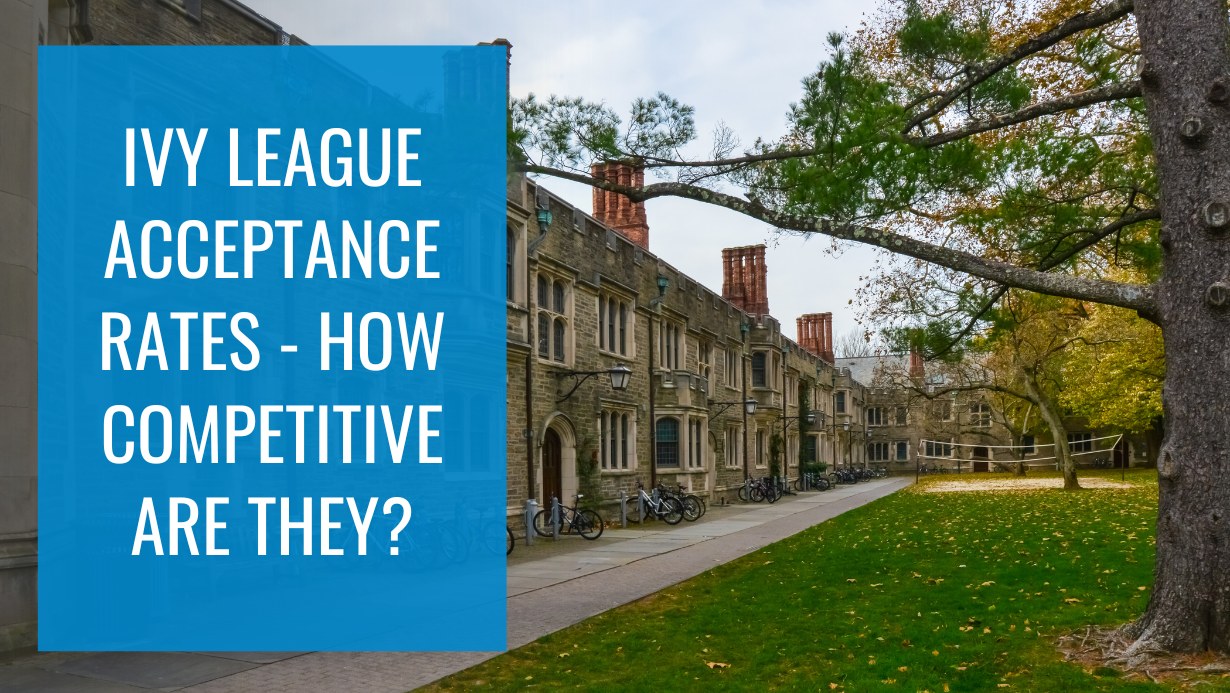For many students, the goal of college admissions is to gain entrance into the Ivy League – a group of eight universities that many believe are the most prestigious institutions in the United States. While there are many other schools alongside the Ivy League (like Stanford, MIT, University of Chicago, Northwestern, Caltech, Duke, etc.) that fill the topmost parts of college ranking systems, the Ivy League carries a level of prestige, name recognition, and history of excellence that many applicants crave.
As each year progresses, the number of applicants to Ivy League schools (generally) increases; however, these eight schools have rarely scaled the size of their first-year classes. The size of their incoming freshman classes has stayed fairly static, despite intensely growing demand for admissions from applicants. For example, the number of applications to Harvard University has grown 45% in the last 8 years. And with the COVID-19 pandemic upending access to testing, which pushed these organizations to adopt test-optional policies, demand grew even more.

So, how competitive are Ivy League admissions? Extremely competitive. These eight schools represent some of the most competitive admissions processes in the world for higher education, underlining the importance of building an angular, competitive profile. That’s what we here at Solomon Admissions do every day with our students – help them hone the most persuasive application anchored by the student’s authentic passions to be most competitive for their desired schools.
What is the Ivy League?
With the exception of Cornell University (founded in 1865), the Ivy League schools all were founded in the colonial period (18th century) and account for 7 of the 9 Colonial Colleges formed before the American Revolution (alongside the College of William and Mary and Rutgers University). Because of this, each Ivy League school boasts a long institutional history.
Sometimes called “The Ancient Eight,” the Ivy League originated as a NCAA Division I athletic conference group in the 1950s. Since then, the focus has shifted away from sports and now encompasses a general sense of academic excellence, intense admissions selectivity (with some acceptance rates below 5%), large financial endowments, world-class faculty, and considerable social capital afforded to its student body. With a strong alumni network, many see the Ivy League as a necessary stepping stone to successful careers.
Eight schools comprise the Ivy League: Brown University, Columbia University, Cornell University, Dartmouth College, Harvard University, University of Pennsylvania, Princeton University, and Yale University.
What Types of Students Get Into Ivy League Schools?
Students applying to the Ivy League have perfect or near-perfect scores, are involved in several high school extracurricular activities, make considerable positive impact in their communities, and demonstrate a deep intellectual curiosity.
Additionally, Ivy League schools are looking for leaders. They don’t want someone whose application looks exactly like hundreds of others; rather, they want to find the singular attributes that make you the strongest candidate in your field, region, etc. Because of this, it’s essential that Ivy League applicants lean into what makes their voice and experience unique.
If you’re early in your high school career, you can make sure to build a profile that deals in singularity, rather than be another application added to a homogenous pile. A lot of high school students are uncomfortable with harnessing their own voice and creating an angular profile, but that’s what you should be leaning into, rather than avoiding. Your Solomon Admissions consultant can help you hone this voice and make it as competitive as possible for the Ivy League admissions processes.
Ultimately, schools like Harvard, Princeton, etc. want their students to take advantage of the resources on campus and then go out into the world and make positive change. This reflects well on the university. Therefore, they look for leaders who will accomplish great things on campus and beyond, which will build the university’s reputation and prestige.
Princeton’s Dean of Admissions Karen Richardson wrote this about the Class of 2024: “These students are artists, scientists, athletes, musicians, caregivers, debaters and much more. Most importantly, through their applications, they showed a real desire to engage with others in the types of critical yet respectful discussions that make Princeton a dynamic place.”
Intense Competition – Ivy League Admissions Statistics
Because of the Ivy League’s level of prestige and high-esteemed academics, competition for its coveted few freshman class spots is fierce. Hundreds of thousands of students from around the world apply each year to the Ivy League. For the Class of 2027, over 400,000 students applied across all eight Ivy League schools. See more detail in the table below:
| Ivy League College | Overall Acceptance Rate | Total Applications Received |
| Brown University | 5.1% | 51,302 |
| Columbia University | 3.9% | 51,129 |
| Cornell University | 7.9% | 67,846 |
| Dartmouth College | 6.2% | 28,841 |
| Harvard University | 3.4% | 56,937 |
| University of Pennsylvania | Not Published (~5%) | 59,463 |
| Princeton University | Not Published (~4.5%) | 39,644 |
| Yale University | 4.4% | 52,250 |
What Does an Acceptance Rate Indicate?
An acceptance rate is a crucial metric for understanding the competitiveness and selectivity of college admissions. These rates, which tend to be very low at the Ivy League schools (as can be seen in the table above), reflect several key aspects of the admissions landscape at these elite institutions, including high demand, extreme selectivity, intense competition, and immense scrutiny paid by the admissions officers on factors like program fit and yield numbers.
What Does Yield Mean?
According to the National Association for College Admission Counseling (NACAC), “An institution’s yield rate is defined as the percentage of admitted students who ultimately enroll at the institution, after considering other admission offers. Accurately predicting yield is critical to colleges, as either over-enrolling or under-enrolling can have important implications.”
For example, if a college/university admits 2,500 students and 2,000 ultimately decide to enroll, the institution’s yield is 80%. Some schools, like Harvard and Stanford, boast yield numbers in the 80-85% range, which is extremely high! Many other schools that are highly ranked have lower yield numbers, like the University of Michigan at 47%. The Ivy League schools are particularly intense about yield protection and try to boast some of the highest yield numbers in the field of college admissions.
College admissions officers spend a significant amount of time considering if the applicants they’re evaluating will actually come to their institution if accepted. Colleges know that competitive applicants will be applying to many schools, so they consider many factors in safeguarding their yield numbers, including some schools considering demonstrated interest, the specificity of the applicant’s essays, connections to the school (doing research with a professor, legacy connections, etc.), and many more factors. Because of yield protection, it’s important to have a balanced college list that isn’t just full of Ivy League schools, but also includes some targets and safety schools, as well.
A Competitive Ivy League Profile
For any Ivy League school, the competition is going to be fierce, and you’ll have to have a list of strong qualifications for the admissions committee to evaluate. It’s worth considering getting help. Solomon Admissions specializes in high stakes admissions consulting. Check out our page detailing our Ivy League admissions consulting services – it’s a great way to help you build a competitive application to the Ivy League, as we can help you craft a deeply angular profile with strengths that align with Ivy League admissions requirements.
Generally, these are the benchmarks you should achieve for a competitive Ivy League application:
- Top 3-5% of high school class (top 1-2% for the more selective Ivies)
- Most challenging courseload of AP/IB courses
- SAT/ACT scores in the 99th percentile
- Glowing letters of recommendation indicating that the student is best out of applicants from the past several years from their high school
- Intense love of learning, as evidenced by academic research outside the classroom with a college professor leading to publication in a peer-reviewed journal
- National awards from academic competitions
- Demonstrated instances of leadership at both local and national levels
Conclusion
Ivy League acceptance ratesUltimately, Ivy League admissions trends will not get less competitive as time goes on unless these schools scale their classes to admit considerably more first-year applicants. Therefore, it’s essential that you build an angular, competitive profile targeted at what the Ivy League looks for in its applicants. Remember – the acceptance rate is just a number, but it reflects several key aspects of the admissions landscape at these elite institutions, including high demand, extreme selectivity, intense competition, and immense scrutiny paid by the admissions officers on factors like program fit and yield numbers. Solomon Admissions consultants will help you navigate the deeply competitive field of Ivy League admissions – schedule a call today!

Former Admissions Reader at Stanford University,
3 Years in Stanford University Admissions,
2,500+ Applications Read and Evaluated,
Peter Zimmerman is a Senior Admissions Consultant with Solomon. Peter earned his Bachelor’s Degree from The College of William and Mary in Art/Art History, with minors in Anthropology and Japanese Studies.
He graduated summa cum laude and was inducted into Phi Beta Kappa – the United States’ oldest honor society for liberal arts colleges. Mr. Zimmerman was one of the first students ever to receive W&M’s prestigious 1693 Scholarship — one of the most distinguished scholarship programs in the country, emphasizing student-led research and academic excellence. In addition, he was awarded W&M’s Martha Wren Briggs Scholarship for academic distinction in Art History. He also attended the Tuck School of Business at Dartmouth.


